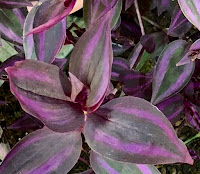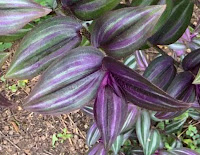|
Tradescantia zebrina - table listing the different names of varieties, cultivars, hybrids
|
 |
| Tradescantia pendula ‘Purple Milano’ |
T. pendula is a synonym for T. zebrina var. zebrina. The (vivid) colors are fading from green to purple on each leaf. (N/A). |
| T. zebrina (thick-leaf; unnamed) |
This zebrina has very thick leaves. (N/A). |
T. zebrina ‘Blue Boy’ photo credits: Madelyn Maddox Purcell |
Probably another name for 'Red Gem'/'Giant'. (N/A). |
| T. zebrina ‘Burgundy’ |
A zebrina with burgundy/vivid magenta leaves (depending on the light and temperature). It's a widely colorful variety, changing from deep burgundy to vivid magenta according to light, season, temperatures. It resembles a lot 'Red Gem' but the colors of that cannot turn vivid magenta (like those of the 'Burgundy' when exposed to morning sunlight). |
T. zebrina var. zebrina variegata 'Danny Lee' |
This is a new variegated zebrina cultivar. The colors resemble those of the T. zebrina var. discolor 'Multicolor' but they are more pastel and less variable. Specific unique features of this variegated Tradescantia zebrina are hairy leaves & tubercles (tiny bumps on the surface of the leaves) that it why the name 'Silver Notches' first proposed[2]. But the cultivar name that was established was finally 'Danny Lee'.
The technical name for this variety is Tradescantia zebrina var. zebrina variegata forma III, describing the third known variegated Tradescantia zebrina cultivar.
|
| T. zebrina ‘Dark Desire’ |
Mostly used in the US; it’s another name for T. zebrina ‘Burgundy’. |
| T. zebrina ‘Deep Purple’ |
The colors of this cultivar are amazing. It has dark magenta stripes on dark - almost black - purple. When this and 'Red Gem' are sun-stressed they look somehow similar to each other, but the colors of 'Red Gem' are much less intense. There were appeared cultivars that look similar ('Red Jewel'; 'Jewel Red'; Purple Joy') but they were treated with PGRs and their vivid colors wear off after some weeks. |
T. zebrina ‘Evanesce’ |
A new zebrina cultivar: Tradescantia zebrina 'Evanesce'; evanesce: to dissipate like vapor. The purple color fades from the new leaves as they age. A very unique T. zebrina. It makes stripes similar to the zebrina from Tikal (see below). It has hairy leaves, and it does have notches in its silver stripes, like 'Danny Lee' has, but there are no tubercles on the surface of the leaves[2]. |
| T. zebrina var. discolor |
This is a reverted Tradescantia zebrina var. discolor 'Multicolor'. From what I know it's the same with T. zebrina ‘Quicksilver’.
|
T. zebrina var. discolor 'Multicolor’
or
T. zebrina var. zebrina variegata forma I |
This is a multicolored variety with highly variable foliage. This is perhaps the most variable in color zebrina. Many confuse it with the 'Quadricolor' but they have differences. This cultivar doesn't develop those dark purple - almost black - stripes like the 'Quadricolor' does. Also, when this cultivar revertes (when kept in low light) the variegation is gone. Whilst on the 'Quadricolor' it may return, is not lost.
The technical name for this variety is Tradescantia zebrina var. zebrina variegata forma I, describing the first known variegated Tradescantia zebrina cultivar. |
| T. zebrina ‘Flame Dance’ |
N/A. This is a discolor variety with random tiny silver flecks on the upper side of the leaves. |
| T. zebrina ‘Giant’ |
Synonym for T. zebrina 'Red Gem'; this cultivar name is mostly used in the States[2]. |
| T. zebrina ‘Little Hill’ |
This zebrina has smaller leaves. Possibly these are plants that were treated with PGRs, as I have heard that after some weeks, the leaves grow normally again, resembling those of the 'Silver Sicilian' cultivar. (N/A). |
| T. zebrina var. discolor ‘Mme Lequesne’ |
This is a discolor variety with large wide leaves and a broken pattern on the stripes (hence the discolor characteristic). |
| T. zebrina ‘Purple Joy’ |
Unofficial cultivar name for Tradescantia zebrina 'Burgundy' plants that were treated with PGRs. At first they look very similar to the Tradescantia zebrina 'Deep Purple' but when after some weeks the chemicals wear off from the plant, all that deep purple/black color is gone and what is left is a Tradescantia zebrina 'Burgundy'. |
| T. zebrina ‘Purple Passion’ |
Yet another name for an already existing zebrina cultivar: Tradescantia zebrina 'Burgundy'. |
| T. zebrina ‘Purple Tinge’ |
The colors have a rather salmon-like tinge and they are fading from green to purple on each leaf. The leaves that are on the tip of the stems have that 'Purple Tinge' fading to green further down the stems. (N/A). |
T. zebrina ‘Quadricolor’
or
T. zebrina var. zebrina variegata forma II |
This is one of the most unique of all T. zebrinas and one of the three variegated ones, with 4 colors (hence the name: quadri (means four) + color. Another unique characteristic of this zebrina - found only among very few variegated plants - is that the variegation is not lost! If a branch reverts back to green, then when this same branch exposed in bright light it will develop again variegation!
The technical name for this variety is Tradescantia zebrina var. zebrina variegata forma II, describing the second known variegated Tradescantia zebrina cultivar. |
| T. zebrina ‘Quicksilver’ |
This is a discolor variety. The leaves have tiny silver flecks. From what I know it's the same with T. zebrina ‘Discolor’. |
| T. zebrina ‘Red Gem’ |
The true 'Red Gem' can be easily distinguished from 'Burgundy' when both are kept on a location with adequate light. The stripes of 'Red Gem' are magenta and the rest of the leaf is green. 'Burgundy' has silvery-green stripes and the rest of the leaf is dark burgundy. The leaves of this zebrina are also bigger. When sun-stressed, it looks similar to T. zebrina 'Deep Purple'. Another cultivar name for this one is T. zebrina 'Giant', mostly used in the States. |
| T. zebrina ‘Red Jewel’ |
A 'Burgundy' that was treated with PGRs. When the chemicals fade away, the plant grows normally again as a T. zebrina 'Burgundy'. |
T. zebrina ‘Silver Notches’ |
This cultivar name is now used to describe the variegated T. zebrina 'Danny Lee'. |
| T. zebrina ‘Silver Sicilian’ |
This zebrina is similar to the 'Silver Plus' but there are differences on the upper structure of the leaf. 'Silver Sicilian' has tubercles towards the base of the leaf, whilst 'Silver Plus' has smooth leaves. |
| T. zebrina ‘Silver Plus’ |
This zebrina is similar to the 'Silver Sicilian' but there are differences on the upper structure of the leaf. 'Silver Plus' has smooth structure towards the base of the leaf, lacking the tubercles that 'Silver Sicilian' has. (N/A). |
| T. zebrina ‘Violet Hill’ |
Possibly a synonym for 'Silver Plus'. (N/A). |
| T. zebrina var. flocculosa |
This zebrina resembles somewhat to the T. sillamontana with cobweb-like hairs on the leaves, but the flowers are blue/indigo color, whereas the flowers of T. sillamontana are magenta. (N/A). |
| T. zebrina var. mollipila |
A naturally occurring zebrina variety with naturally variegated leaves. On this variety the - typical double zebrina - stripes are light silver/green/gray and there's also a single purple stripe running from the base of the petiole to the tip of the leaf. The magenta margins on each leaf gives to this natural variety an amazing contrast of colors! (N/A). |
T. zebrina var. mollipila ‘Purple Plush’ |
This is a cultivated variety of the T. zebrina var. mollipila, with beautiful burgundy/brown/purple stripes on the upper side of the leaves, something totally missing from the original natural variety. These purple stripes may disappear when the plant is exposed in very intense or in low light, but they will appear again in normal growing conditions. |
| T. zebrina var. purpusii |
The true purpusii does not have stripes like the rest of the zebrinas. The colors of the leaves are brown/red to light magenta (depending on the light, location, season and temperatures). On a location with less bright light the colors may turn greener, starting from the center of the leaf. But when exposed to normal light conditions, the natural colors of this variety will return. There's also the cultivar name 'Purpusii' (Tradescantia zebrina 'Purpusii') but it's actually a discolored zebrina with faint stripes and not the true purpusii. |
|
This is a naturally occuring variety near Tikal, Mexico. It resembles somewhat to the mollipila 'Purple Plush' but the leaves are larger, less round, mostly in arrow-shape, with vivid purple stripes on both sides of the leaf . This natural zebrina variety was rescued from its natural habitat in Mexico, but it carries a kind of bacterial infection. This infection doesn't seem to be contagious, but during low temperatures the plant loses its colors and it grows slower (mostly green) with a few (the typical zebrina) stripes. When exposed again to the higher temperatures in summer, it appears to grow normal again. At the moment, experienced Commelinaceae collectors have not managed to determine (and reverse) the course of that viral infection. TS (Tissue Culture) might be an option to try and clear this natural variety from that viral - yet harmless - infection. |
| T. zebrina var. zebrina |
The common wild forma; mainly green foliage with silver/lighter green stripes. |
 |









































